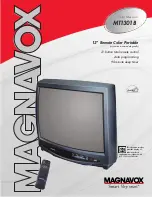
– 20 –
DIGITAL CONTROL CIRCUITS
Digital electronic controls replace the mechanical customer controls. This
provides a more precise setting of the controls as well as allowing the
convenience of remote operation. The BUS data output from the CPU for
each Control Register are essentially the same as those previously described
for the Sound Control Circuit.
The BUS Interface circuit (see diagram below) is necessary to transfer each
control data in the BUS data from the CPU into a corresponding Control
Register in the Signal Processor IC101, and the MTS Processor IC3401.
After accessing the on-screen main menu system with the MENU key and
selecting the Picture/Sound Manual adjustment menu with the CH
▲
/
▼
and
VOL – / + keys, digital control is carried out by pressing the MENU key for
seven separate controls. the CH
▲
/
▼
key is used to select the control to
be changed. Each time a CH
▲
/
▼
key is pressed, the mode will advance
to the next control. The sequence is: Color, Tint, Contrast, Brightness,
Sharpness, Bass and Treble. the active control will be displayed on the
screen and then can be adjusted with the VOL – / + keys.
It takes 140 ms per step to change the control level with the VOL – / + keys.
There are 64 step control level changes in each control mode with the output
characteristics of each control mode independent of the others. When a VOL
– / + key is pressed it takes approximately 5 seconds to change from center
to minimum or center to maximum. The BUS data changes for the controls
are the same as those shown for the volume control.
When the FACTORY PRESET mode is selected with the RESET key, the
Picture/Sound controls will return to the factory settings. During FACTORY
PRESET mode the settings are as follows: COLOR 32/64*
1
, TINT 32/64*
1
,
CONTRAST 64/64*
2
, BRIGHTNESS 32/64*
3
, SHARPNESS 32/64*
4
, BASS
32/64, TREBLE 32/64. Furthermore, the FACTORY PRESET mode clears all
the other customized settings.
When the FACTORY PRESET mode is selected, the customized settings of
the digital controls will be reset. If desired, customized settings can be made
again using the on-screen menu.
*
1
A 7-bit control data up to 127 steps are output for each control register.
One and one half of the customer control steps (1.5x64 =96 steps) are
assigned for customer setting and the remainder (31 steps) are
provided for service adjustment.
*
2
A 7-bit control data up to 127 steps are output for this control register.
One and one half of the customer control steps (1.5x64 =96 steps) are
assigned for customer setting and the remainder (31 steps) are always
output.
*
3
A 7-bit control data up to 127 steps are output for this control register.
64 steps are assigned for customer setting and the remainder (63
steps) are provided for service adjustment.
*
4
A 5-bit control data up to 31 steps are output for this control register.
One fourth of the customer control steps (1/4x64=16 steps) are
assigned for customer setting and the remainder (15 steps) are
provided for service adjustment.
















































